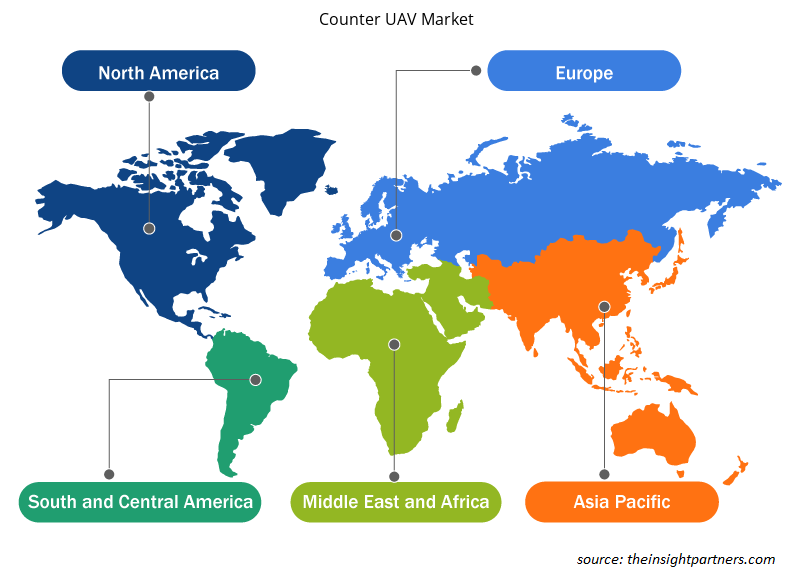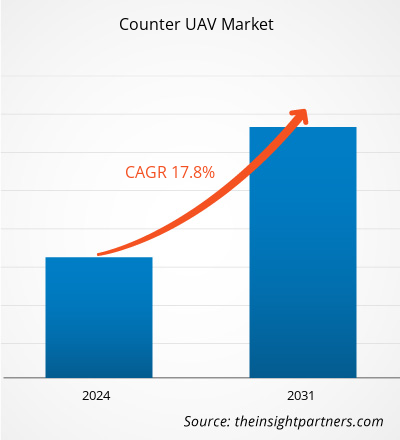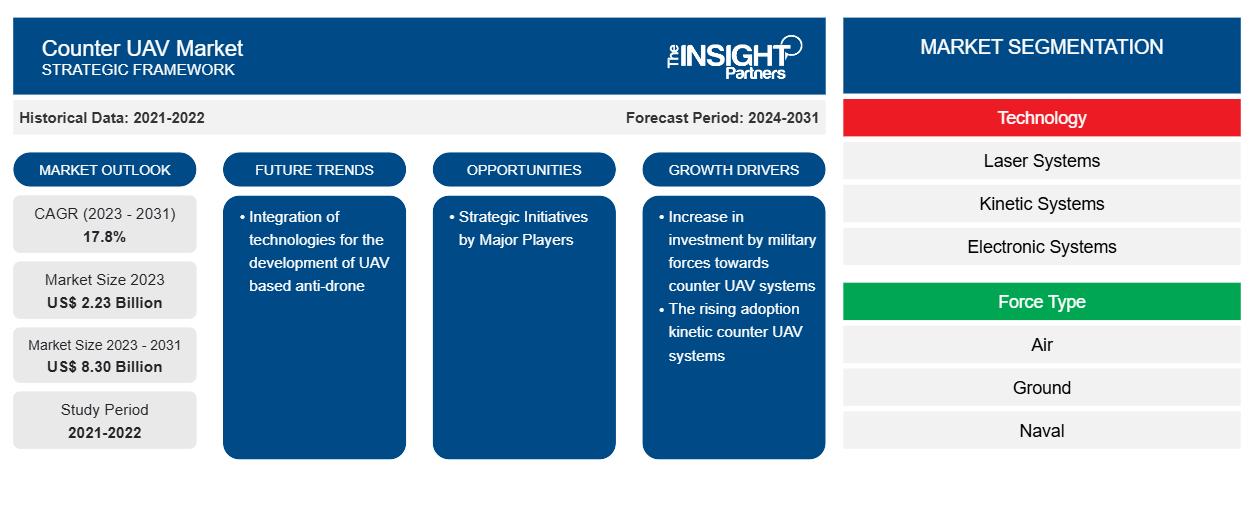Der Markt für Drohnenabwehrsysteme soll von 2,23 Milliarden US-Dollar im Jahr 2023 auf 8,30 Milliarden US-Dollar im Jahr 2031 anwachsen. Für den Zeitraum 2023–2031 wird ein durchschnittliches jährliches Wachstum von 17,8 % erwartet. Die Integration von Technologien zur Entwicklung von Drohnenabwehrsystemen dürfte ein wichtiger Trend auf dem Markt bleiben.
Marktanalyse für Gegendrohnen
Lockheed Martin Corporation, Thales Group, Northrop Grumman Corporation, Leonardo SpA und Rafael Advanced Defense Systems Ltd gehören zu den wichtigsten Marktteilnehmern auf dem globalen Markt für Drohnenabwehr. Die wichtigsten Akteure werden unter Berücksichtigung von Faktoren wie Gesamtumsatz, aktuellem Produktportfolio für Drohnenabwehr, geografischer Reichweite, Marktinitiativen, Investitionen in Technologie-Upgrades, Partnerschaften und anderen marktbezogenen Aktivitäten aufgelistet.
Marktübersicht für Gegen-UAVs
Zu den wichtigsten Akteuren im globalen Ökosystem des Marktes für Drohnenabwehr zählen unter anderem Komponentenhersteller, Systemintegratoren und Endnutzer. Ein Radar für Drohnenabwehrsysteme besteht aus verschiedenen Komponenten wie Sensoren und GPS-Systemen , die die Systemhersteller von einer großen Anzahl von Komponentenherstellern beziehen. Diese Komponentenhersteller liefern die Basisteile an die Akteure auf dem globalen Markt für Drohnenabwehr. Die Systemintegratoren sind die Unternehmen, die nach der Integration der einzelnen Komponenten mit der Herstellung der Anti-Drohnen-Systeme beschäftigt sind. Zu den wichtigsten Akteuren auf dem Markt gehören unter anderem Raytheon Technologies Corporation, Rafael Advanced Defense Systems Ltd., Thales Group, Lockheed Martin Corporation und Israel Aerospace Industries Ltd. Zu den Endnutzern des globalen Marktes für Drohnenabwehr zählen Luft-, Land- und Seestreitkräfte, die sich mit der Verteidigung und der inneren Sicherheit der Länder befassen. Die Drohnenabwehrlösungen werden auch zunehmend von den inneren Sicherheitskräften für private globale Veranstaltungen und Konzerte eingesetzt. Daher führen auch die steigenden Militärausgaben der Industrie- und Entwicklungsländer und ihre zunehmenden Investitionen zum Schutz der Landes- und Küstengrenzen vor feindlichen Drohnen zu einer weltweiten Verbreitung von Lösungen zur Abwehr unbemannter Luftfahrzeuge (UAV).
Passen Sie diesen Bericht Ihren Anforderungen an
Sie erhalten kostenlos individuelle Anpassungen an jedem Bericht, einschließlich Teilen dieses Berichts oder einer Analyse auf Länderebene, eines Excel-Datenpakets sowie tolle Angebote und Rabatte für Start-ups und Universitäten.
-
Holen Sie sich die wichtigsten Markttrends aus diesem Bericht.Dieses KOSTENLOSE Beispiel umfasst eine Datenanalyse von Markttrends bis hin zu Schätzungen und Prognosen.
Markttreiber und Chancen für Counter-UAVs
Zunehmende Einführung kinetischer UAV-GegensystemeUAV Systems
Kinetische Drohnenabwehrsysteme werden von Militärorganisationen auf der ganzen Welt eingesetzt, um Drohnen vollständig auszuschalten. Dabei kommen Drohnenabwehrleinen oder -netze zum Einsatz, die in der Regel mithilfe von Druckluft oder einem anderen UAV abgefeuert werden. Diese Geräte helfen dabei, die Drohne einzufangen, zu neutralisieren oder zu zerstören. Manchmal werden unbekannte Drohnen innerhalb von Militärgebieten eingesetzt, um das Gebiet zu erkunden oder den Aufenthaltsort des Gegners genau im Auge zu behalten. In solchen Fällen sorgt die Zerstörung der gesamten Drohne für mehr Sicherheit für die Streitkräfte.UAV systems are used by military bodies across the globe to completely take down a drone. It utilizes anti drone weight lines or nets which is generally launched with the help of compressed air, or another UAV. These devices help to capture the drone, neutralize it or destroy the same. Some time, unknown drones are sent within military boundaries to study the area or to keep a close eye to the opponents where-abouts. In such cases, destroying the complete drone ensures enhanced safety to the military forces.
Zu den großen Unternehmen, die kinetische Abwehrsysteme für Drohnen anbieten, gehören unter anderem KWESST Micro Systems Inc. und Zen Technologies Limited. KWESST Micro Systems Inc. bietet Mikrodrohnen zur kinetischen Abwehr kleiner Drohnen, einschließlich Schwärmen, die von Soldaten gestartet werden können. Es handelt sich um eine vollautomatische Drohne, die dabei hilft, Drohnen zu identifizieren, zu verfolgen, zu jagen und mit kinetischer Technologie zu neutralisieren. Diese Systeme decken auch eine Reichweite von 4 km ab. Das Unternehmen kündigte im Oktober 2021 die Entwicklung eines neuen Abwehrsystems für Drohnen als Reaktion auf die schnell zunehmende Bedrohung durch herumlungernde Munition an.UAV systems include KWESST Micro Systems Inc. and Zen Technologies Limited amongst others. KWESST Micro Systems Inc., offers micro-drone for kinetic interdiction of small drones, including swarms, that can be launched by soldiers. It is a fully automatic drone which helps in the dentification of drones, track, hunt and neutralize them with kinetic technology. These systems also cover a range of 4km. The company in October 2021, announced the development of new counter UAV system in response to the rapidly increasing threat of loitering munitions.
Strategische Initiativen wichtiger Akteure
Die zunehmenden Terroranschläge und die politische Instabilität in verschiedenen Industrie- und Entwicklungsländern veranlassen die Verteidigungs- und Heimatschutzkräfte dazu, ihre Beschaffung von fortschrittlichen Lösungen wie Radarsystemen, Kommunikationssystemen und Anti-Drohnen-Technologien zu erhöhen. So haben beispielsweise das Verteidigungsministerium der USA, der Europäischen Union und andere Behörden wie das indische Verteidigungsministerium ihre Ausgaben für die Beschaffung von Anti-Drohnen im Laufe der Jahre erhöht. Dies führt dazu, dass die Hersteller von Anti-Drohnen-Systemen organische und anorganische Wachstumsstrategien wie hohe Investitionen, Produktangebote und globale Expansion verfolgen, was weitere Wachstumschancen für den globalen Markt für Anti-Drohnen-Systeme schafft.amongst others. For instance, department of defense of US, European Union and other authorities like Indian defense ministry has increased their spending on procurement of anti-drones over the years. This is leading the counter UAV manufacturers to adopt organic and inorganic growth strategies, such as high investments, product offerings, and global expansion, further creating growth opportunities for the global counter UAV market.
Segmentierungsanalyse des Counter UAV-Marktberichts
Wichtige Segmente, die zur Ableitung der Marktanalyse zur Abwehr von Drohnen beigetragen haben, sind Technologie, Truppentyp, Produkttyp, Konfiguration und Endbenutzer.
- Basierend auf der Technologie ist der Markt für Gegen-UAVs in Lasersysteme, kinetische Systeme und elektronische Systeme unterteilt. Das Segment der elektronischen Systeme hatte im Jahr 2023 einen größeren Marktanteil.
- Basierend auf der Art der Streitkräfte ist der Markt für Gegendrohnen in Luft-, Boden- und Marine-Segmente unterteilt. Das Bodensegment hatte im Jahr 2023 einen größeren Marktanteil.
- Basierend auf dem Produkttyp ist der Markt für Gegen-UAVs in bodengestützte und tragbare Geräte unterteilt. Das bodengestützte Segment hatte im Jahr 2023 einen größeren Marktanteil.
- Basierend auf der Konfiguration ist der Markt für Gegen-UAVs in tragbare und stationäre unterteilt. Das stationäre Segment hatte im Jahr 2023 einen größeren Marktanteil.
- Basierend auf der Konfiguration wird der Markt für Gegen-UAVs in Verteidigung und Heimatschutz unterteilt. Das Verteidigungssegment hatte im Jahr 2023 einen größeren Marktanteil.
Marktanteilsanalyse für Gegen-UAVs nach geografischer Lage
Der geografische Umfang des Marktberichts zum Thema Drohnenabwehr ist hauptsächlich in vier Regionen unterteilt: Nordamerika, Europa, Asien-Pazifik und Rest der Welt.
Nordamerika dominierte den Markt im Jahr 2023, gefolgt von Europa und dem asiatisch-pazifischen Raum. Darüber hinaus wird der asiatisch-pazifische Raum in den kommenden Jahren voraussichtlich die höchste durchschnittliche jährliche Wachstumsrate verzeichnen. Die USA hatten den größten Anteil am nordamerikanischen Markt für Drohnenabwehrsysteme. Die Anti-UAV-Systeme helfen der US-Armee laut dem US-Verteidigungsministerium (DOD) dabei, feindliche oder angreifende Drohnen zu erkennen und zu neutralisieren. Aufgrund ihrer Größe, ihres Baumaterials und ihrer Flughöhe sind viele kleinere UAS für typische Luftabwehrsysteme nicht erkennbar. Daher rechnet das US-Verteidigungsministerium (DOD) damit, im Geschäftsjahr 2022 mindestens 636 Millionen US-Dollar für die Forschung und Entwicklung von Anti-UAS (C-UAS) sowie mindestens 75 Millionen US-Dollar für die Beschaffung von C-UAS auszugeben, was einer Steigerung von 134 Millionen US-Dollar gegenüber dem Geschäftsjahr 2021 entspricht. Da das US-Verteidigungsministerium diese Technologien weiterhin entwickelt, kauft und einsetzt, trägt es zum Wachstum des Marktes bei.
Regionale Einblicke in den Markt für Gegen-UAVs
Die regionalen Trends und Faktoren, die den Markt für Counter-UAVs im Prognosezeitraum beeinflussen, wurden von den Analysten von Insight Partners ausführlich erläutert. In diesem Abschnitt werden auch die Marktsegmente und die Geografie von Counter-UAVs in Nordamerika, Europa, im asiatisch-pazifischen Raum, im Nahen Osten und Afrika sowie in Süd- und Mittelamerika erörtert.

- Erhalten Sie regionalspezifische Daten zum Markt für Gegen-UAVs
Umfang des Marktberichts zu Gegen-UAVs
| Berichtsattribut | Details |
|---|---|
| Marktgröße im Jahr 2023 | 2,23 Milliarden US-Dollar |
| Marktgröße bis 2031 | 8,30 Milliarden US-Dollar |
| Globale CAGR (2023 - 2031) | 17,8 % |
| Historische Daten | 2021-2022 |
| Prognosezeitraum | 2024–2031 |
| Abgedeckte Segmente |
Nach Technologie
|
| Abgedeckte Regionen und Länder |
Nordamerika
|
| Marktführer und wichtige Unternehmensprofile |
|
Marktteilnehmerdichte: Der Einfluss auf die Geschäftsdynamik
Der Markt für Counter-UAVs wächst rasant, angetrieben durch die steigende Nachfrage der Endnutzer aufgrund von Faktoren wie sich entwickelnden Verbraucherpräferenzen, technologischen Fortschritten und einem größeren Bewusstsein für die Vorteile des Produkts. Mit steigender Nachfrage erweitern Unternehmen ihr Angebot, entwickeln Innovationen, um die Bedürfnisse der Verbraucher zu erfüllen, und nutzen neue Trends, was das Marktwachstum weiter ankurbelt.
Die Marktteilnehmerdichte bezieht sich auf die Verteilung der Firmen oder Unternehmen, die in einem bestimmten Markt oder einer bestimmten Branche tätig sind. Sie gibt an, wie viele Wettbewerber (Marktteilnehmer) in einem bestimmten Marktraum im Verhältnis zu seiner Größe oder seinem gesamten Marktwert präsent sind.
Die wichtigsten auf dem Markt für Gegen-UAVs tätigen Unternehmen sind:
- Blighter Surveillance System Ltd
- Dedrone
- Drohnenschild
- Israel Aerospace Industries Ltd.
- Leonardo SPA
Haftungsausschluss : Die oben aufgeführten Unternehmen sind nicht in einer bestimmten Reihenfolge aufgeführt.

- Überblick über die wichtigsten Akteure auf dem Counter UAV-Markt
Neuigkeiten und aktuelle Entwicklungen zum Counter UAV-Markt
Der Markt für Gegendrohnen wird durch die Erhebung qualitativer und quantitativer Daten nach Primär- und Sekundärforschung bewertet, die wichtige Unternehmensveröffentlichungen, Verbandsdaten und Datenbanken umfasst. Nachfolgend sind einige der Entwicklungen auf dem Markt für Gegendrohnen aufgeführt:
- Elbit Systems stellt auf der Paris Airshow als Teil seiner Unified EW-Suite eine neue und einzigartige Funktion für elektronische Kriegsführung (EW) vor. Die neue Funktion wird über die digitalen Radarwarnempfänger (RWR) bereitgestellt, die Teil von Elbits bewährter luftgestützter Selbstschutz-EW-Suite sind, und ermöglicht die Erkennung und Identifizierung von Drohnen sowie die Ortung von Personal Location Beacons (PLB) von Bodentruppen und Piloten. (Quelle: Elbit Systems Ltd, Pressemitteilung, Juni 2023)
- Elbit Systems Ltd (NASDAQ:ESLT und TASE: ESLT) Elbit Systems gab heute bekannt, dass es einen Auftrag im Wert von rund 55 Millionen US-Dollar zur Lieferung mehrschichtiger ReDrone Counter Unmanned Aerial Systems (C-UAS) an die Niederlande erhalten hat. Der Auftrag wird über einen Zeitraum von vier Jahren ausgeführt. (Quelle: Elbit Systems Ltd, Pressemitteilung, August 2023)
Marktbericht zu Gegendrohnen (Counter UAV) – Abdeckung und Ergebnisse
Der Bericht „Marktgröße und Prognose für Counter UAVs (2021–2031)“ bietet eine detaillierte Analyse des Marktes, die die folgenden Bereiche abdeckt:
- Marktgröße und Prognose für Counter UAVs auf globaler, regionaler und Länderebene für alle wichtigen Marktsegmente, die im Rahmen des Berichts abgedeckt sind
- Berücksichtigen Sie UAV-Markttrends sowie Marktdynamiken wie Treiber, Einschränkungen und wichtige Chancen
- Detaillierte Porter-Fünf-Kräfte-Analyse
- Marktanalyse für Gegendrohnen (Counter UAV), die wichtige Markttrends, globale und regionale Rahmenbedingungen, wichtige Akteure, Vorschriften und aktuelle Marktentwicklungen umfasst
- Branchenlandschaft und Wettbewerbsanalyse, die die Marktkonzentration, Heatmap-Analyse, prominente Akteure und aktuelle Entwicklungen für den Markt für Gegen-UAVs umfasst
- Detaillierte Firmenprofile
- Historische Analyse (2 Jahre), Basisjahr, Prognose (7 Jahre) mit CAGR
- PEST- und SWOT-Analyse
- Marktgröße Wert/Volumen – Global, Regional, Land
- Branchen- und Wettbewerbslandschaft
- Excel-Datensatz
Aktuelle Berichte
Erfahrungsberichte
Grund zum Kauf
- Fundierte Entscheidungsfindung
- Marktdynamik verstehen
- Wettbewerbsanalyse
- Kundeneinblicke
- Marktprognosen
- Risikominimierung
- Strategische Planung
- Investitionsbegründung
- Identifizierung neuer Märkte
- Verbesserung von Marketingstrategien
- Steigerung der Betriebseffizienz
- Anpassung an regulatorische Trends























 Kostenlose Probe anfordern für - Markt für Gegen-UAVs
Kostenlose Probe anfordern für - Markt für Gegen-UAVs